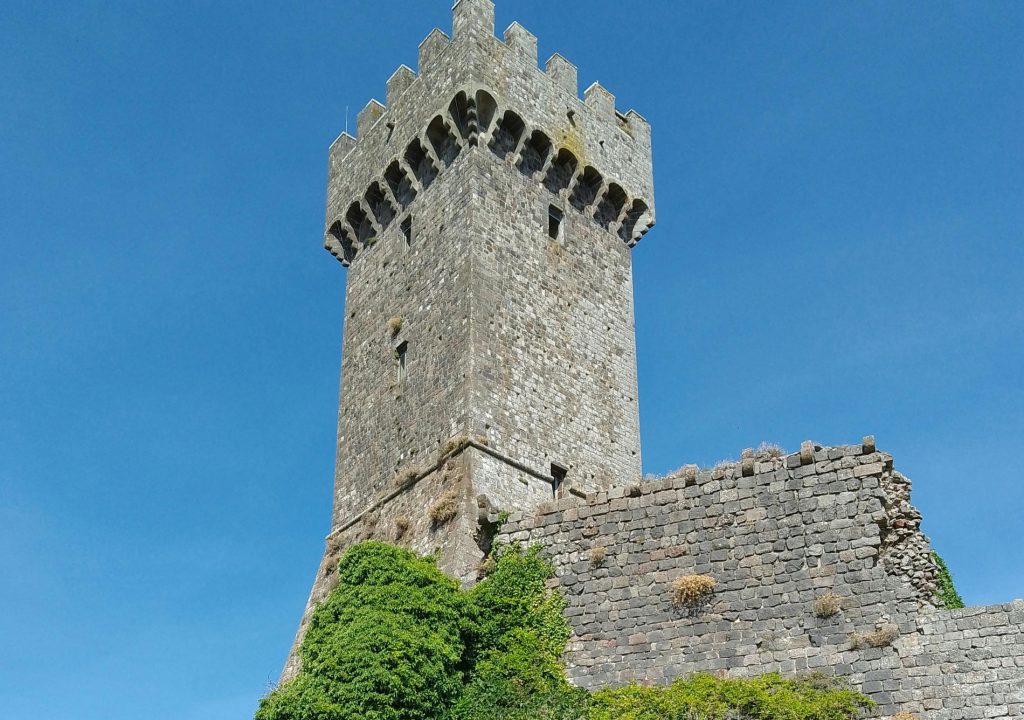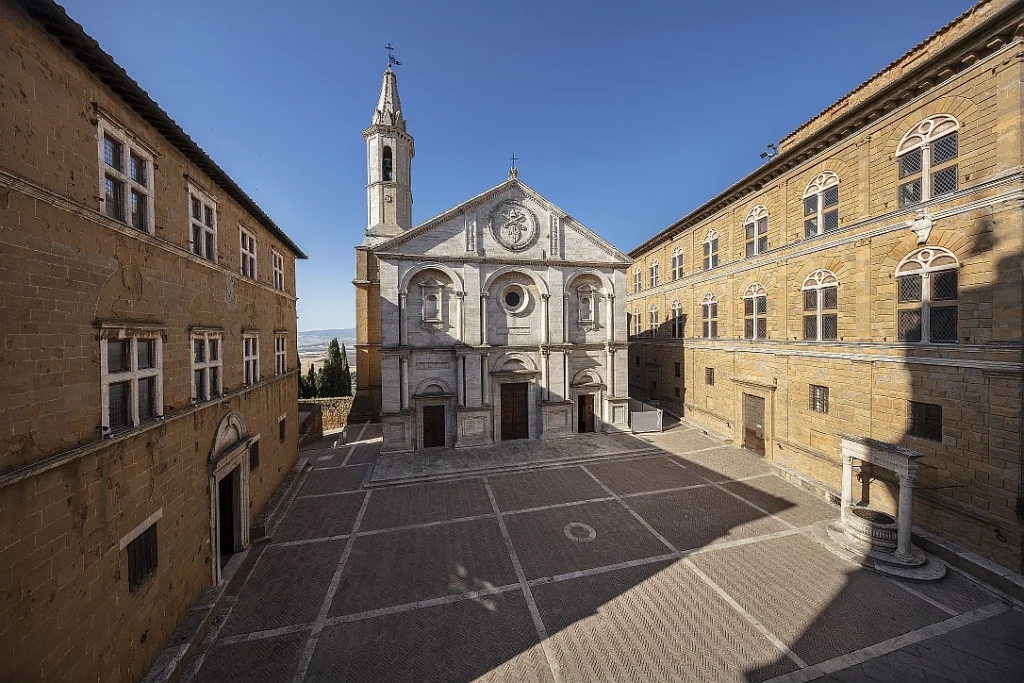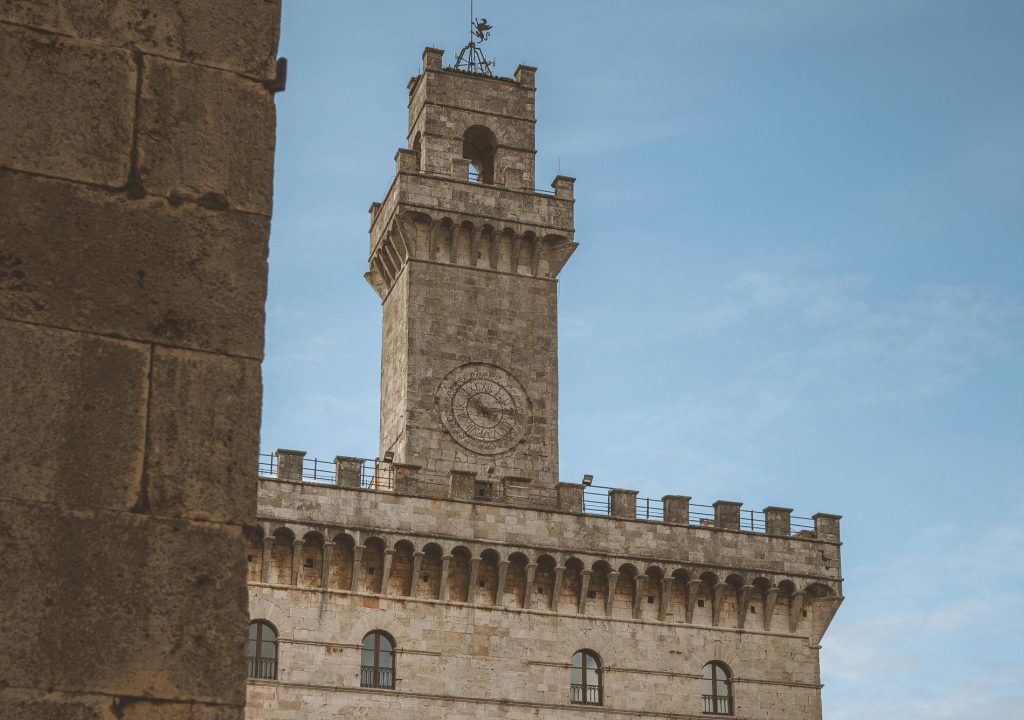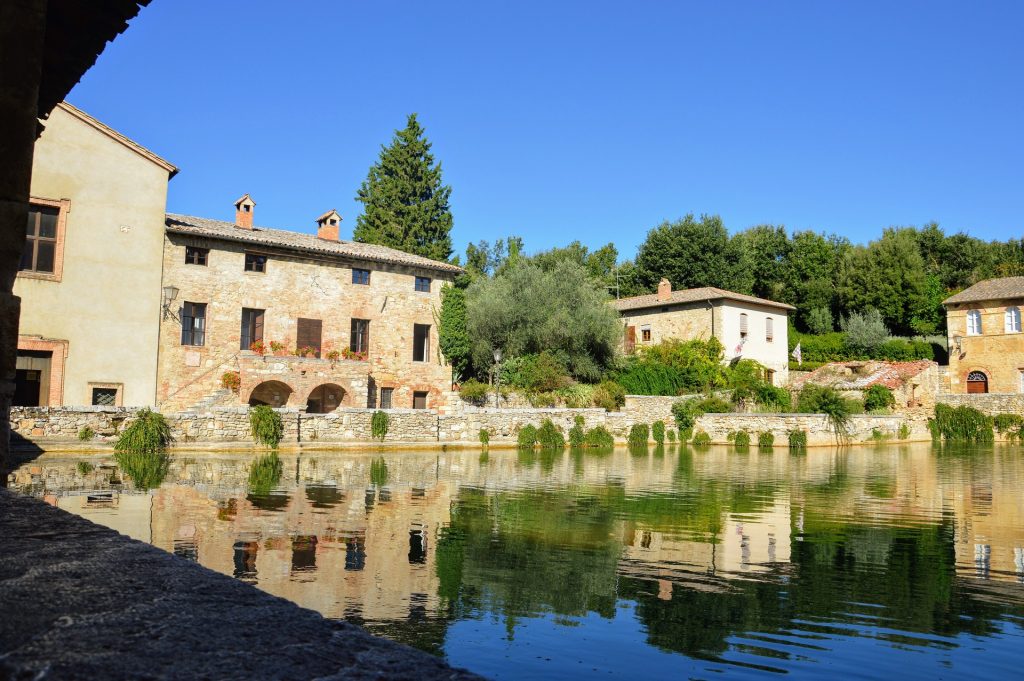Val d'Orcia and surroundings
Art Villages in Tuscany: Radicofani, Pienza, Montepulciano, Chianciano, San Quirico d'Orcia, Bagno Vignoni, Montalcino, Sarteano

RADICOFANI
From an isolated rock, it dominates the Val d’Orcia, from which rise the ruins of an ancient castle. It was an important border town for the Roman state. The fortifications built by Cosimo I were destroyed by the explosion of a powder magazine in 1735. Radicofani remains famous for the exploits of the bandit Ghino di Tacco, who lived here for many years.
Terracottas by Luca della Robbia are housed inside the church of
San Pietro; the church of Sant’Agata, in Sienese-Gothic style, is of architectural interest. The charming 16th-century post office building with its double-loggia facade is located along the Via Francigena. Illustrious figures such as Chateaubriand, Dickens, and Montaigne stayed here. Montaigne was a lover of good food and appreciated the use of olive oil in cooking certain dishes. Furthermore, in his writings, he often recalls the Tuscan warmth and
hospitality.
Terracottas by Luca della Robbia are housed inside the church of
San Pietro; the church of Sant’Agata, in Sienese-Gothic style, is of architectural interest. The charming 16th-century post office building with its double-loggia facade is located along the Via Francigena. Illustrious figures such as Chateaubriand, Dickens, and Montaigne stayed here. Montaigne was a lover of good food and appreciated the use of olive oil in cooking certain dishes. Furthermore, in his writings, he often recalls the Tuscan warmth and
hospitality.

PIENZA
Originally “Castello di Corsignano,” Pienza took its current name in honor
of Pope Pius II Piccolomini, who initiated its renovation in the second half of the 15th century, aimed at realizing the utopian image of an ideal city. The entire town is a little gem worth seeing, but particular attention should be paid to the Cathedral, which houses works by Giovanni di Paolo, Matteo di Giovanni del Vecchietta, and Sano di Pietro; there is also a marble altar attributed to Rossellino, the architect who was commissioned by Pope Pius II to redesign the city. Adjacent to the Cathedral is the “Diocesan Museum,” where you can admire works from the school of Sodoma and Sano di Pietro, as well as Flemish tapestries from the 15th and 16th centuries. A few
meters away is the beautiful Palazzo Piccolomini, built to a design by
Bronzino and Beccafumi. Below the town lies the enchanting landscape
of the “Val d’Orcia Artistic, Natural and Cultural Park,” with gullies, rolling fields, and the famous chalk cliffs.
of Pope Pius II Piccolomini, who initiated its renovation in the second half of the 15th century, aimed at realizing the utopian image of an ideal city. The entire town is a little gem worth seeing, but particular attention should be paid to the Cathedral, which houses works by Giovanni di Paolo, Matteo di Giovanni del Vecchietta, and Sano di Pietro; there is also a marble altar attributed to Rossellino, the architect who was commissioned by Pope Pius II to redesign the city. Adjacent to the Cathedral is the “Diocesan Museum,” where you can admire works from the school of Sodoma and Sano di Pietro, as well as Flemish tapestries from the 15th and 16th centuries. A few
meters away is the beautiful Palazzo Piccolomini, built to a design by
Bronzino and Beccafumi. Below the town lies the enchanting landscape
of the “Val d’Orcia Artistic, Natural and Cultural Park,” with gullies, rolling fields, and the famous chalk cliffs.

MONTEPULCIANO
The splendid town, which for its artistic and architectural remains has been called the “Pearl of the 16th Century,” preserves its beauty intact.
Climbing through the steep streets, visitors will discover beautiful palaces and churches where the greatest Renaissance architects infused their
unparalleled art. Worth seeing is the splendid Piazza Grande, with the Duomo with its incomplete façade and the Palazzo Comunale; all around are Renaissance palaces. In the valley below the town, in an unforgettable
view, the elegant structure of the Temple of San Biagio stands out.
Montepulciano is also a center of lively cultural activity: among
the most famous events are the “Cantiere Internazionale d’Arte” and the
popular performance of the “Bruscello.” The agricultural economy, which has always been very important, is now accompanied by a strong tourism vocation, one of the most important of which is the Terme di Montepulciano, in the Sant’Albino area, where the healing properties of the water and mud are exploited.
Climbing through the steep streets, visitors will discover beautiful palaces and churches where the greatest Renaissance architects infused their
unparalleled art. Worth seeing is the splendid Piazza Grande, with the Duomo with its incomplete façade and the Palazzo Comunale; all around are Renaissance palaces. In the valley below the town, in an unforgettable
view, the elegant structure of the Temple of San Biagio stands out.
Montepulciano is also a center of lively cultural activity: among
the most famous events are the “Cantiere Internazionale d’Arte” and the
popular performance of the “Bruscello.” The agricultural economy, which has always been very important, is now accompanied by a strong tourism vocation, one of the most important of which is the Terme di Montepulciano, in the Sant’Albino area, where the healing properties of the water and mud are exploited.

CHIANCIANO
Certainly one of the most famous and important spa towns in Italy;
moreover, the presence of a significant human settlement that would have constituted a large Etruscan-Roman center is probably linked to the waters. Important evidence of this is the discovery of a monumental thermal complex currently being excavated in the central “Mezzomiglio” area. Many other artifacts from the Etruscan and Roman eras, some of which were recently discovered, are on display in the Civic Archaeological Museum “Delle Acque”. The spa town arose adjacent to the old medieval Chianciano, which contains small treasures of Romanesque and Renaissance art. Some of these treasures—such as paintings from the Sienese and Florentine schools, by followers of Duccio di Buoninsegna and Arnolfo di Cambio—can be admired in the Museum of Sacred Art at the Palazzo dell’Arcipretura. Chianciano is located approximately 550 meters above sea level. Nestled in large forests of oak, beech, holm oak, and chestnut trees, between the Valdichiana and Val d’Orcia, where, along with the typically Tuscan landscape, we can still admire bastions, fortresses, castles, and abbeys. This uncontaminated environment surrounds the famous thermal mineral springs; Chianciano Terme therefore offers all the climatic and tourist advantages deriving from its geographical position.
moreover, the presence of a significant human settlement that would have constituted a large Etruscan-Roman center is probably linked to the waters. Important evidence of this is the discovery of a monumental thermal complex currently being excavated in the central “Mezzomiglio” area. Many other artifacts from the Etruscan and Roman eras, some of which were recently discovered, are on display in the Civic Archaeological Museum “Delle Acque”. The spa town arose adjacent to the old medieval Chianciano, which contains small treasures of Romanesque and Renaissance art. Some of these treasures—such as paintings from the Sienese and Florentine schools, by followers of Duccio di Buoninsegna and Arnolfo di Cambio—can be admired in the Museum of Sacred Art at the Palazzo dell’Arcipretura. Chianciano is located approximately 550 meters above sea level. Nestled in large forests of oak, beech, holm oak, and chestnut trees, between the Valdichiana and Val d’Orcia, where, along with the typically Tuscan landscape, we can still admire bastions, fortresses, castles, and abbeys. This uncontaminated environment surrounds the famous thermal mineral springs; Chianciano Terme therefore offers all the climatic and tourist advantages deriving from its geographical position.

SAN QUIRICO D’ORCIA AND BAGNO VIGNONI
Of Etruscan origin, it gained importance thanks to the nearby Via Franchigena. Frederick Barbarossa welcomed the ambassadors of Pope Adrian IV here in 1154, a event commemorated with the “Barbarossa Festival” on the third Sunday of June. In 1167, it was the seat of the Imperial Vicariate. Florence, under Cosimo I de’ Medici, acquired it in 1559. The Collegiate Church of Saints Quirico and Giuditta is in Romanesque style: it has three portals, the one at the southern end being attributed to Giovanni Pisano. Inside, there is a polita by Sano di Pietro and a choir from 1432-1502. Palazzo Chigi dates back to the 17th century. The “Horti Leonini” (16th century) are one of the earliest examples of Italian gardens: from August to October, the sculpture exhibition “Forma nel verde” is held. The Romanesque parish church of Santa Maria Assunta was perhaps built on the ruins of a pre-Christian temple. The interior of the church of San Francesco houses two polychrome wooden statues and a Madonna della Robbia. The hamlet of Bagno Vignoni has been known since Roman times for its beneficial waters that spring at a temperature of over 50°C and are collected in the “vascone” (large basin) located in the center of the village, giving it a very enchanting appearance. A small shrine is dedicated to Saint Catherine of Siena, located in the portico beside the basin. Vignoni Castle overlooks the town and can be reached from both San Quirico and Bagno Vignoni, along a nature trail that can also be explored on foot.

MONTALCINO
Montalcino (564 m) sits atop a hill overlooking the valleys
of the Orcia, Arbia, and Ombrone rivers. Walking around the city, you can
admire – in addition to the splendid views – numerous medieval
buildings, starting with the Town Hall – the former seat of the Priors –
an austere stone building decorated with coats of arms and surmounted by a tall tower, with monumental loggias and Gothic and round-arched arches from the 14th-15th centuries. This is followed by the neoclassical cathedral, built on a 11th-century parish church, whose Baptistery Chapel houses
interesting sculptures; the Sanctuary of the Madonna del Soccorso, erected in the 17th century on a 15th-century church near the corniolo gate; the Gothic-Romanesque Sant’Agostino; Sant’Egidio (also known as the Church of the Sienese) from the early 14th century; San Francesco with a square tower. Civic Museum – Madonna and Child with Saints John and Peter, Robbiana terracotta from 1507; Saint Sebastian, another Robbiana terracotta from the 15th century. Archaeological Museum – Paleolithic, Neolithic, Bronze, and Iron Age finds, cinerary urns, and Etruscan vases. Diocesan Museum – Romanesque Crucifix from the early 13th century; parts of a polyptych by Luca di Tommè; Madonna and Child from the School of Duccio di Buoninsegna
of the Orcia, Arbia, and Ombrone rivers. Walking around the city, you can
admire – in addition to the splendid views – numerous medieval
buildings, starting with the Town Hall – the former seat of the Priors –
an austere stone building decorated with coats of arms and surmounted by a tall tower, with monumental loggias and Gothic and round-arched arches from the 14th-15th centuries. This is followed by the neoclassical cathedral, built on a 11th-century parish church, whose Baptistery Chapel houses
interesting sculptures; the Sanctuary of the Madonna del Soccorso, erected in the 17th century on a 15th-century church near the corniolo gate; the Gothic-Romanesque Sant’Agostino; Sant’Egidio (also known as the Church of the Sienese) from the early 14th century; San Francesco with a square tower. Civic Museum – Madonna and Child with Saints John and Peter, Robbiana terracotta from 1507; Saint Sebastian, another Robbiana terracotta from the 15th century. Archaeological Museum – Paleolithic, Neolithic, Bronze, and Iron Age finds, cinerary urns, and Etruscan vases. Diocesan Museum – Romanesque Crucifix from the early 13th century; parts of a polyptych by Luca di Tommè; Madonna and Child from the School of Duccio di Buoninsegna

SARTEANO
The imposing square keep of the 10th-century castle clearly speaks of the medieval origins of Sarteano, a town that extends along a hilltop overlooking the Valdichiana. Sarteano also boasts secular and religious buildings of undoubted interest; in particular, a visit to the church of San Martino in Foro is recommended; the Collegiate Church, dedicated to Saints Lorenzo and Apollinaris, also boasts valuable works.
Secular buildings include the Town Hall, Palazzo Piccolomini, Palazzo
Goti-Fanelli, and Palazzo Cennini; the Teatro degli Arrischianti is also a small gem. The Civic Archaeological Museum is certainly worth a visit, which displays important Etruscan and Roman artifacts. Every year, on the 15th of August, the “Giostra del Saracino” takes place, a thrilling horseback challenge of medieval origin. A few kilometers from the center, passing through dense and pristine woods, you reach the fortified Abbey of Spineto and the medieval village of Castiglioncello del Trinoro.
Secular buildings include the Town Hall, Palazzo Piccolomini, Palazzo
Goti-Fanelli, and Palazzo Cennini; the Teatro degli Arrischianti is also a small gem. The Civic Archaeological Museum is certainly worth a visit, which displays important Etruscan and Roman artifacts. Every year, on the 15th of August, the “Giostra del Saracino” takes place, a thrilling horseback challenge of medieval origin. A few kilometers from the center, passing through dense and pristine woods, you reach the fortified Abbey of Spineto and the medieval village of Castiglioncello del Trinoro.
